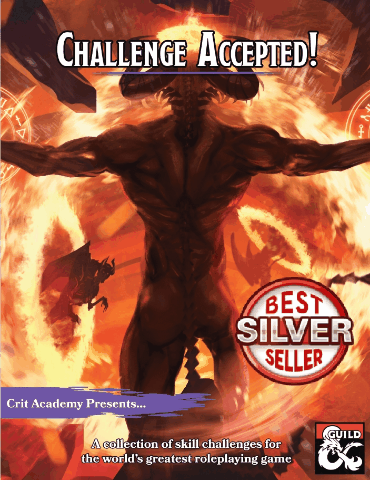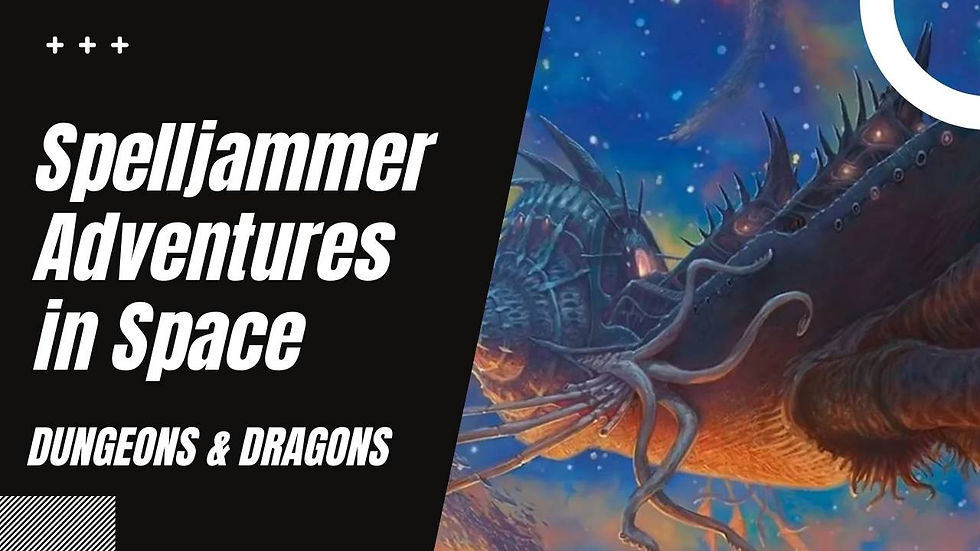How to Create and Run Mini-Games in Dungeons & Dragons
- Justin Handlin

- Oct 23, 2021
- 7 min read
Adventurers spend a great deal of time delving into dungeons, uncovering lost secrets, and slaying monsters. In between all the action, they need a bit of a break from the familiar. What better way than with Mini-Games? Well then hold on to your dice and join us as we discuss how to create and run Mini Games in Dungeons & Dragons.
Crit Academy interviews Game Designer Geoffery Golden. Geoffrey has written for Capcom, Ubisoft, Square Enix, Disney, and indie studios around the world. Driven by a love for telling compelling interactive stories in a variety of mediums, his work spans TTRPGs, console games, mobile games, zines, comic books and much more. Below is an outline for the interview.
What is a Mini-Game?
Definition – As I see it, a mini-game is a standalone game that lives within a larger game experience. (Versus, say, a “micro RPG,” which is a small game that lives entirely on its own, or a puzzle trap in a castle, which I’d call an “element.”)
Adventurers have Hobbies too.
Fun – I see the value of mini-games as adding a type of entertainment experience to the table players wouldn’t normally get from a typical session. For example, a casino-type card game or an icebreaker “getting to know our characters” game.
Theming
Ideally, mini-games streamline with narrative, emotional, and/or mechanical themes in the larger game. Otherwise, they’ll feel like diversions, rather than building blocks to telling a larger story.
Pacing
To prevent a mini-game from "taking over” the session, consider tools like time limits and finite goals. Also, playtesting. There’s no substitute for playtesting.
Geoffrey, tell us a little bit about one of your more recent projects, Target Run
Target Run is an anarchic archery adventure in the tradition of sports movies like Caddyshack
and The Mighty Ducks.
Could your party use a little R&R? Then check into the world-class treetop resort of Overtop
Heights, home of the sun elf archery sport Alligan. Enjoy opulent amenities like fine dining, a tree sap spa, stolen treasure, a hammer-wielding groundskeeper, magical murder-hawks, pixie revolutionaries attempting a takeover, and the softest beds imaginable.
Join the fun-loving Tasvan on her quest to become the first dwarf to play Alligan at Overtop
Heights. Your adventurers will crash parties, fight bullies, catch cheaters, live in luxury, and
beat the superstars of Alligan at their own game to help Tasvan, earn gold, and shake up the
study world of Overtop Heights!
Visit Geoffrey: https://www.geoffreygolden.com/

Extraordinary Expeditions is a collection of modular adventures designed on a flexible framework to be easily tossed into any fantasy setting. Scour the Desolate Wastelands for the lost library of Zenith Athenaeum. Save, escort, and protect villagers as they seek a safe haven, while two towering titans do battle. Venture into a village completely overrun by monstrous creatures from the Far Realm. Complete with adventures, maps, and monster stat blocks.
One of the best parts about any roleplaying game isn’t just the fantastic battles. It’s the memorable locations that they take place in, and the interesting NPCs that our heroes encounter. Our goal was to build a project that included all these great points. With Crit Academy’s expertise in 5th Edition and Arjade Productions’ masterful knowledge of 3.5 rules, we believe Extraordinary Expeditions will hit on all these points and so much more.
Unearthed Tips and Tricks
Character Concept: Tasvan, Female Dwarf
Description: Tasvan is a young dwarf with bright green eyes, a big goofy smile, and long reddish-brown hair, tied into an up-do. She wears a sleeveless wool top with tough leather shoulder and knee pads, along with sturdy boots. Armed with only a simple, circular wooden shield, she wears a gold necklace, and carries bags of gold in her pockets, because you never know when you'll need some gold.
Personality: Tasvan is a rich, boisterous, and fun-loving superfan of the high elf sport Alligan. Dwarves are not allowed to play Alligan at the highest level, but that hasn't dampened her enthusiasm. Tasvan trains every day with her regulation Alligan shield. Her constant jokes and jabs, social stamina, and willingness to tip big make her the life of any party – and the bane of straight-laced authority figures, like the kind who tend to run Alligan tournaments.
History: All her life, Tasvan has been obsessed with Alligan, much to the bewilderment of her dwarf family and friends. When she was a kid, she had an Overtop Alligan Talis set – hard to get in the hilltops. She became a miner and saved a stockpile of gold to venture from the hills into the forest to try her hand at professional Alligan at Overtop Heights, the elite elven treetop resort. Though Tasvan presents as a dwarf, she doesn’t know her real father was actually a wood elf.
Motivation: Tasvan is determined to break through the "elf ceiling" and become the first dwarf to play Alligan at Overtop Heights. She wants to see her childhood dream come true. Or as she would put it, "I wanna be an Alligan legend. I can’t go back to the mines. I’m allergic to hard work!"
Monster: Justicar
Origin: Oni
Lost Features:
Spell List, Regeneration, Glaive (replaced with a Maul), Change shape, Claw.
New Features:
Spell List:
Cantrips: mending, thaumaturgy
3/day: divine favor, guiding bolt, speak with dead
2/day: lesser restoration, silence
1/day: death ward
Actions:
Justicar’s Challenge. The justicar attempts to compel a creature into a duel. One creature that the justicar can see within 30 feet must succeed on a DC 13 Wisdom saving throw. On a failed save, the creature is drawn and compelled to the justicars demand. For up to one minute (as if concentrating on a spell), the creature has disadvantage on attack rolls against creatures other than the justicar, and must make a Wisdom saving throw each time it attempts to move to a space that is more than 30 feet away from the justicar; if it succeeds on this saving throw, this effect doesn’t restrict the target’s movement for that turn.
The effect ends if the justicar attacks any other creature, casts a spell that targets a hostile creature other than the target, if a creature friendly to it damages the target or casts a harmful spell on it, or if the justicar ends its turn more than 30 feet away from the target.
Legendary Actions
The justicar can take 3 legendary actions, choosing from the options below. Only one legendary action option can be used at a time and only at the end of another creature's turn. The justicar regains spent legendary actions at the start of its turn.
Cantrip. The justicar casts a cantrip.
Healing Touch (5/Day). The justicar touches another creature. The creature regains 9 (2d6 + 3) hit points.
Blinding Blast (Costs 2 Actions). The justicar targets one creature it can see within 30 feet of it. The target must succeed on a DC 13 Constitution saving throw or be blinded until the end of its next turn.
Encounter: Tavern Game: 18 Mules: Tribality
18 mules is a variation of the classic and well-known Blackjack card game but contextualized in a way that feels more real in a fantasy setting while also making it a dice game.
The purpose of the game is to carry your wagon full of gold without spending any more than needed. For that, you as a player roll 3d6. After doing so, you can add an extra roll to the pile as many times as you want in order to have the sum be as closest to 18 as possible. You can decide to stop at any time, but the farther you are, the less points you get. Moreover, if the sum ever surpasses 18 you lose your turn and the next player gets to do the same from the start.
The dice are supposed to represent the number of mules you bought from the farmer. You only have 18 ropes to tie the wagons to the mule, and fewer mules don’t have enough strength to carry the gold all the way to the nearest town without making any stops. I know, it’s a pretty lame excuse for why the game plays that way, but so were the instructions for those kinds of games.
The objective is to score 100 points. The number of mules you have when you decide to stop adding is the number of points you get. If you surpass 18, you get no points. Last but not least, are you to get a perfect score of 3 sixes in the first three dice you roll in your turn you not only immediately win 18 points but also 10 extra points.
Roleplaying the NPCs: in a fantasy setting the gods of luck are very prominent during gambling and are called upon for luck all the time. Make sure to mention Tymora, or whichever god/goddess of luck there is in your setting when roleplaying an NPC. If you want them to be cheaters, make them whisper the names of the gods of trickery and divination. A smart player might be able to comprehend the situation after hearing this.
Magic Item: Slagshaper’s Stagger Hammer
Weapon (warhammer), uncommon (requires attunement)
Forged with the slag from a powerful magical artifact. The slagshaper dwarves let nothing of power go unused. You gain a +1 bonus to attack and damage rolls made with this magic weapon. In addition, while you are attuned to this weapon, if you score a critical hit against a creature, the creature must succeed on a DC 13 Constitution saving throw or become stunned until the end of its next turn.
Dungeon Master Tip: Know your Design Strengths and Styles
Very few Dungeon Masters are great at every aspect of the game. For example, some may be excellent at weaving complex interconnected stories, but fall flat on combat encounter designs. Another may have mastered the art of combat narration and NPC personas, but has difficulty catching the nuances of faction motives and politics. This is ok, and expected. Few master every aspect of the game. Being able to identify your strengths and weaknesses can take your gaming to the next level. The reason is, instead of delivering flat combat encounters in your complex tails, you can look to collaborate with another who excels at combat encounter design. By teaming up with someone with high-quality skills that cover your weakness, not only does your game become better. But, you can offer your skills to improve their game. It’s a win-win for everyone. But, most importantly, it allows you a secondary party to bounce a variety of different ideas off of.
Player Tip: Mementos
Nearly every person that becomes an adventurer has endured some difficult challenges. Many have lost family and friends. Entire clans and kingdoms rise and fall during the life of long-lived adventurers such as elves. As a reminder of this hardship, it becomes common for many adventurers to carry some sort of memento from their previous life. When building your character consider creating a memento that serves as a reminder of a particularly challenging moment in your character’s life.
If you enjoy the content and want to support us, visit our store or follow us on social media, join us on discord, youtube, and leave us a review.
Keep your blades sharp and spells prepared heroes!
*Crit Academy is an Affiliate of Amazon, DMsguild and DriveThruRPG*
















Comments